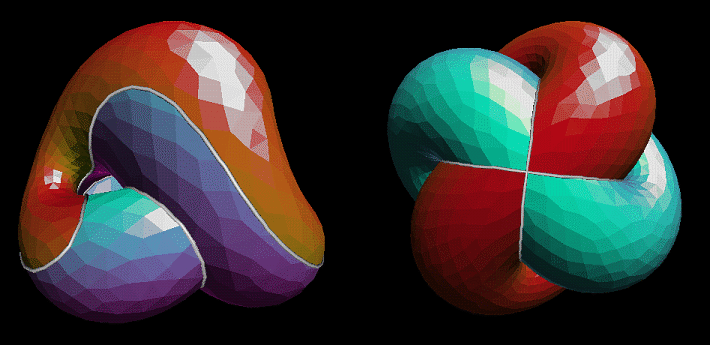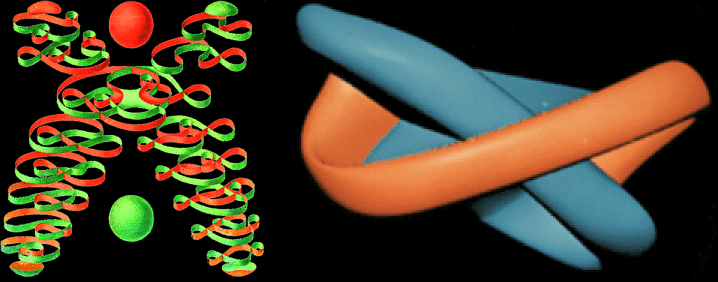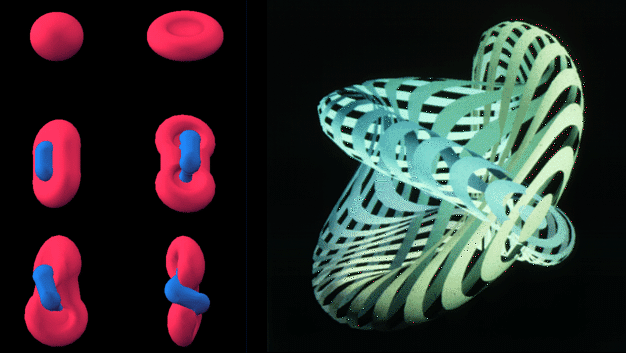
|
To evert a sphere is to turn it inside-out by means of a continuous deformation, which allows the surface to pass through itself, but forbids puncturing, ripping, creasing, or pinching the surface. An abstract theorem proved by Smale in the late 1950s implied that sphere eversions were possible [Sm], but it remained a challenge for many years to exhibit an explicit eversion. Because the self-intersecting surfaces are complicated and nonintuitive, communicating an eversion is yet another challenge, this time in mathematical visualization. More detailed histories of the problem can be found in [Le] and in Chapter 6 of [Fr]. |
|
The earliest sphere eversions were designed by hand, and made use of the idea of a halfway-model. This is an immersed spherical surface which is halfway inside-out, in the sense that it has a symmetry interchanging the two sides of the surface. If we can find a way to simplify the halfway-model to a round sphere, we get an eversion by performing this simplification first backwards, then forwards again after applying the symmetry. The eversions of Arnold Shapiro (see [FM], Tony Phillips [Ph], and Bernard Morin [MP] can all be understood in this way. |
|
In practice, two kinds of halfway-models have been used, shown in Fig. 1. The first, used by Shapiro and by Phillips (see Fig. 2, left), is a Boy's surface, which is an immersed projective plane. In other words it is a way of immersing a sphere in space such that antipodal points always map to the same place. Thus there are two opposite sheets of surface just on top of each other. If we can succeed in pulling these sheets apart and simplifying the surface to a round sphere right-side-out, then pulling them apart the other way will lead to the inside-out sphere. |
|
The other kind of halfway-model is a Morin surface; it has four lobes, two showing the inside and two the outside. A ninety-degree rotation interchanges the sides, so the two halves of the eversion differ by this four-fold twist. Morin (whose blindness incidentally shows that mathematical visualization goes well beyond any physical senses) and Apéry [AM] have shown that an eversion based on a Morin surface halfway-model has the minimum possible number of topological events. |

|
Figure 1: These are the halfway-models for the first two minimax eversions. The Boy's surface (left), an immersed projective plane with three-fold symmetry and a single triple point, minimizes Willmore's elastic bending energy. The figure actually shows an immersed sphere, double covering Boy's surface, with the two (oppositely-oriented) sheets pulled apart slightly. The Morin surface shown (right) also minimizes Willmore energy; it has a four-fold rotational symmetry which reverses orientation, exchanging the red and blue sides of the surface. |

|
Figure 2: This drawing (left) by Tom Prentiss illustrates one stage of Tony Phillips' sphere eversion [Ph] based on a Boy's surface. This frame (right) from Nelson Max's classic computer animation of a Morin eversion shows a stage near the halfway-model, renderd by Jim Blinn. |
|
Models of this eversion were made by Charles Pugh, and Nelson Max
digitized these models and interpolated between them for his famous
1977 computer graphics movie "Turning a Sphere Inside Out" [Ma]
a frame of which is shown in Fig. 2.
Morin eversions have also been implemented on computers
by Robert Grzeszczuk and by John Hughes (see Fig. 3),
among others. These eversions have usually been laboriously
created by hand, splining or interpolating between key frames,
or looking for algebraic or trigonometric equations.
|
 Figure 3: Still pictures from the Morin eversion implementions by Robert Grzeszczuk (left) and John Hughes (right). |
|
A new proof of Smale's original theorem, providing more geometric insight, was developed by Bill Thurston (see [Le]). His idea was to take any continuous motion (homotopy) between two surfaces, and make it regular (taking out any pinching or creasing), when this is possible, by adding corrugations in a controlled way; the corrugations make the surface more flexible. This kind of sphere eversion was beautifully illustrated in the computer-graphics video "Outside In" [OI] produced at the Geometry Center in 1994 (see Fig. 4). |

|
Figure 4: These pictures, from "Outside In", show a very different sphere eversion, implemented by means of Thurston's corrugation technique. |
|
The corrugation idea is quite natural, and provides a way to understand all regular homotopies, not just the sphere eversion. However, the resulting eversion, though nicely full of symmetry (except, interestingly, the temporal symmetry seen in all sphere eversions based on halfway-models), is quite elaborate, and has many more topological events than necessary. |
